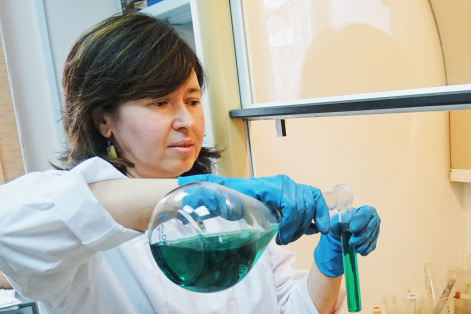New reagent will make it possible to completely extract palladium from industrial wastes
22 December 2020 г.

Palladium is widely used in industry, for example, to create electronic and biomedical devices. However, the content of this element in natural deposits is extremely low. Therefore, scientists are looking for ways to obtain palladium from industrial wastes and secondary resources such as spent nuclear fuel, catalysts and waste from electronic devices. Liquid extraction is one of the most effective methods for recovering palladium from waste. It involves the extraction of the valuable substance from a solution using a special compound - an extractant.
Chemists of the Federal Research Center "KSC SB RAS" together with colleagues from Novosibirsk extracted palladium from nitrate solutions with a new sulfur-phosphorus reagent - dithiophosphinic acid disulfide. Due to its high selectivity, the new extractant can almost completely extract palladium from waste materials without involving impurities of other metals.
Siberian scientists carried out liquid extraction of palladium from nitrate solutions using dithiophosphinic acid disulfide diluted in toluene. The researchers note that the recovery of palladium by disulfide is slow. The chemists hypothesized that the slow extraction is due to the low rate of formation of palladium complex compounds in the solution. In order to speed up the process, they had to increase the concentration in the organic phase of the reaction and raise the reaction temperature. As a result, complete extraction of palladium was achieved within 10-20 minutes.
“We have confirmed that disulfide can be used to recover palladium from nitric acid solutions containing some metal impurities. We have also demonstrated that dithiophosphinic acid disulfide is a highly effective and highly selective extractant. In only one extraction stage, almost a complete recovery of palladium is observed, while the recovery of impurity metals is extremely low. Disulfide-based extraction systems can be used in the processing of nitrate solutions obtained by leaching various raw materials, including spent fuel from nuclear power plants, spent catalysts and electronic waste, ”says Natalya Grigorieva, Candidate of Chemical Sciences, Senior Researcher at the Institute of Chemistry and Chemical Technology KSC SB RAS.
Chemists also warn that in this preliminary study, toluene was used to dilute the reagent, but in practice it is necessary to use less toxic and more fire-resistant diluents identical to toluene, among which triethylbenzene can be indicated.
Share:
